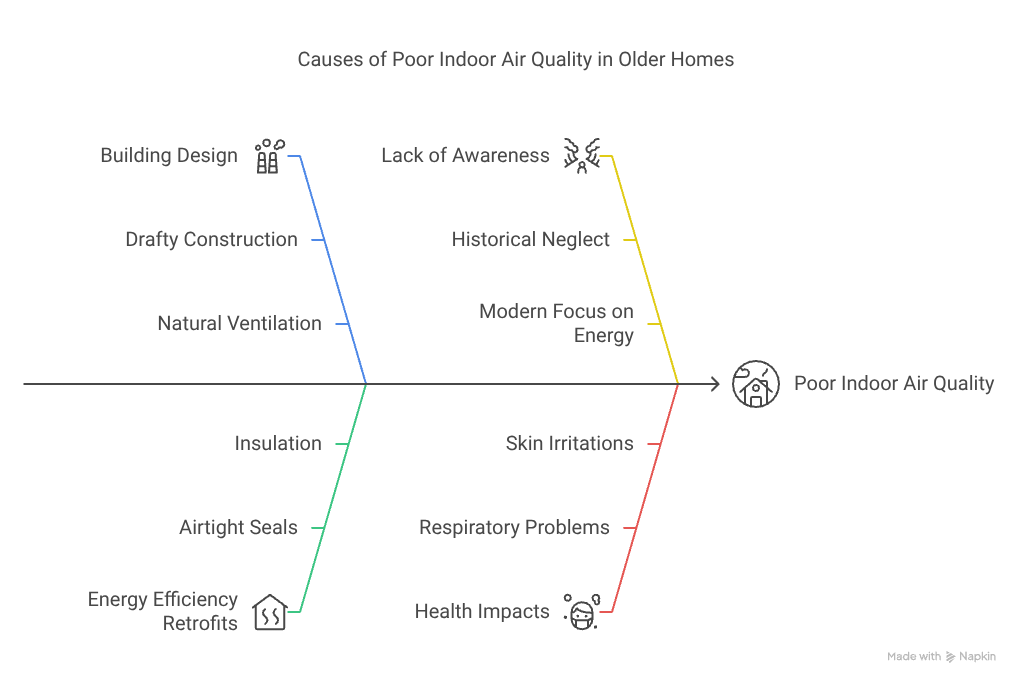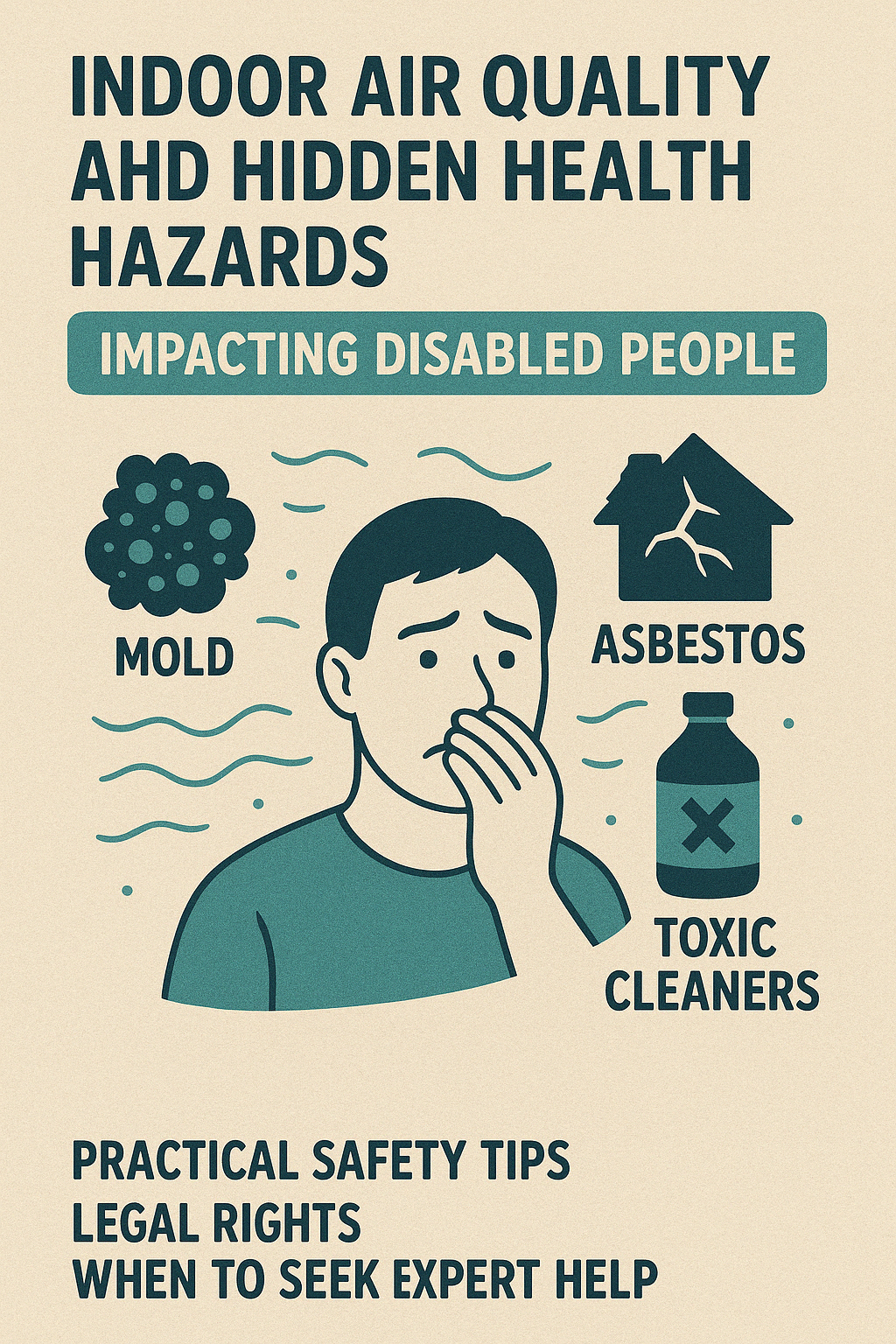The Air Inside Our Homes
The air in our homes can be seem fresh but it often isn’t! Even if everything looks clean, there can still be problems.
Tiny dust bits float around the rooms. Vapours from things like sprays and paint mix into the air. We don’t always see or smell them.
These hidden things can affect our health and can change how comfortable we feel. This matters even more for people who stay indoors a lot which can include many disabled people.
In this article, we will look at how indoor air affects disabled people and share easy ways to make your home safer and healthier.
Why Bad Air Is a Bigger Problem for Disabled People
The World Health Organization says bad air can harm our bodies. It can cause stress inside the body, swelling, and a weaker immune system. This can make people ill more often.
Disabled people can be affected more than others. Many already have health problems. These problems may affect the brain, lungs, or immune system. Bad air inside the home can make these problems worse. It can also cause more pain and sickness.
Some people live in older homes with unsafe building materials. These materials can still release harmful chemicals or gases into the air.
For some disabled people, home is more than just a place to relax. It is where they spend most of their time, work and get the help they need.
Why Indoor Environmental Health Matters More for Disabled People
The risks of poor indoor air quality are grave, as the WHO reveals. For instance, 12% of all deaths due to ischemic heart disease and stroke are the direct result of household air pollution.
Similarly, 11% of lung cancer deaths and 23% of fatalities caused by chronic obstructive pulmonary disease (COPD) are due to poor indoor air quality. These stats are for the general population. Disabled people are even more vulnerable to household contaminants for the following reasons –
- Their mobility issues or chronic illness means they spend more of their day indoors, increasing pollutant exposure.
- Certain disabilities accompany respiratory and immune system sensitivities, which may cause severe reactions to even low pollutant levels.
- Since some disabled people cannot always move about as freely, they’re often helpless in the face of poor ventilation, mold, or other allergens.
Common Indoor Health Risks in Older or Inaccessible Housing
Older housing refers to residential buildings built before modern safety and accessibility standards were enforced. This makes them more likely to contain harmful environmental hazards.
Disabled people living in such houses may face the following common indoor health risks.
Poor Ventilation and Mould in Older Homes
Many older homes were not built to keep the air clean inside. Back then, people didn’t think much about indoor air quality.

These homes were often drafty. Air could move in and out through cracks, open windows, and chimneys. This helped fresh air come in naturally and helped bad air leave the house.
Nowadays, we block drafts to keep warm and save money but this also stops fresh air from coming in. Without good airflow, bad air and fumes can build up inside.
Moreover, some older homes contain airtight retrofits for increased energy efficiency. As a result, the home traps moisture and stale air, leading to mould growth.
Research by UK government shows that mould spores can cause a stuffy nose, skin rash, wheezing, etc. Those with asthma or weakened immune systems may suffer more severe reactions or chronic lung disease.
Even if you can’t see mould, just having damp in the home can still be a problem.
Damp can help germs grow, like:
- Mould and fungi
- Dust mites
- Bacteria
- Viruses
The worse the damp and mould get, and the longer it stays, the more it can harm your health.
Dust, Pet Dander, and Allergens
Older homes often feature aged carpets, rugs, and upholstery. These materials gradually break down and their fibers release into the air, trapping particles like mold spores, pet dander, etc.
Dust is also a common issue, especially if the hard-to-reach spaces like attics and air ducts haven’t been cleaned or renovated in decades. Only a thorough, regular cleaning routine and air purifiers with HEPA filters can tackle these common allergens.
Toxic Cleaning Chemicals
Strong cleaning products like bleach and ammonia can make indoor air more harmful. They add more pollution to the air.
In older homes, there are often soft and spongy materials like old wood or plaster. These can soak up the strong chemicals, making the problem even worse.
That’s why it’s better to use safer cleaning products. Simple things like vinegar and baking soda can clean well without filling the air with toxic fumes.
These safer choices are very important for people who are sensitive to chemicals.
Even small amounts of strong cleaners can make some people feel unwell.
Asbestos: The Hidden Danger in Older Properties
Asbestos is a dangerous leftover from the past that still hides in many old homes. It is a natural material, but it is toxic and unsafe to breathe in. Builders used asbestos a lot between the 1940s and 1980s. It was used in walls, ceilings, floors, and pipes.
Even though we know it is harmful now, it can still be found in older buildings today.
By the late 1990s, both the UK and the US banned asbestos use. However, it continues to pose health risks due to the legacy of past construction. It’s possible to find asbestos in the following areas of ageing buildings –
- Floor tiles
- Ceilings and walls
- Pipes and heating systems
- Roof shingles
- Basements and attics
- Insulation
Asbestos in older properties is a complex legal and health concern, especially for tenants and disabled residents. Asbestos fibers are released into the air when any asbestos-containing material is damaged or disturbed. This is why DIY renovations are dangerous. Asbestos exposure even happens during building deterioration.
If you believe you’ve been exposed, or if a landlord failed to remove asbestos safely, you can take legal action.
In the US, asbestos lawsuits have been filed by those who developed an incurable, life-threatening cancer called mesothelioma. A successful lawsuit requires proving negligence on the landlord’s part. This means it must be established that the victim’s mesothelioma is directly connected to asbestos exposure.
In the UK, landlords have a legal duty to identify, assess, and manage asbestos risks in rental properties, particularly if the building was constructed before the 1980s. If asbestos-containing materials are in good condition and unlikely to be disturbed, the law does not require immediate removal—regular monitoring is sufficient. However, if these materials are damaged or could be disturbed (for example, during renovations), landlords must take prompt action to remove or safely encapsulate the hazard using licensed professionals. Tenants should be informed of any known asbestos risks, and can report concerns to the local council. If a landlord fails to manage asbestos risks, local authorities can enforce remediation, and tenants may have grounds for legal action if they suffer harm as a result of negligence. It’s crucial never to disturb suspected asbestos materials yourself; always seek professional assessment and follow safety guidance to prevent exposure to airborne fibres, which can cause serious diseases like mesothelioma and lung cancer many years after exposure
Safety Tips for Disabled Tenants and Homeowners

In light of the dangers that indoor environmental pollutants pose for disabled people, it’s important to take proper safety measures. Here are some ways disabled tenants and homeowners can protect themselves –
- Ask landlords for an asbestos survey if the property was constructed before the 1980s.
- Install HEPA air filters for highly effective filtration.
- Use non-toxic household cleaners to prevent greater health complications.
- Prevent mold growth by sealing cracks and moisture-prone areas.
- Regulate airflow by keeping all rooms well-ventilated.
Where to Seek Expert Help
Local Council for Environmental Health
The local council is responsible for managing and enforcing environmental health regulations. You can contact them for any air quality issues in your home.
For instance, get in touch for advice on how to prevent outdoor pollution from reducing the quality of indoor air. Another reason can be assistance with pest control, which may contribute to poor indoor air quality.
NHS for Health Concerns
The National Health Service is responsible for our medical care in the UK. The first stop is your GP or calling 111 due to
- Health symptoms due to air pollution
- Worsening of symptoms due to pre-existing respiratory issues
- Suspected carbon monoxide poisoning due to faulty gas appliances or heating systems
- Exposure to hazardous substances
Legal Professionals
A third group of experts whose support you can seek is legal professionals. We previously mentioned how disabled people can take legal action against landlords or property managers for asbestos exposure.
If problems are getting worse and those responsible are not getting them fixed, you can get help from a lawyer.
The lawyer can help you take legal action. This might lead to an agreement or payment to cover:
Medical costs
Stress or upset feelings caused by the bad air
FAQs
What Should I Do if I Suspect Asbestos in My Flat?
If you suspect your flat has asbestos, it’s important not to disturb the fibers. Check the age of your property and notify the landlord or property manager. Don’t try to remove it yourself. You can arrange for a professional inspection. The professionals will advise you on the best course of action.
Can Air Purifiers Help With Mold or Asthma?
Yes, air purifiers can help with mold or asthma, but their effectiveness depends on the type and quality of the purifier. Overall, purifiers with HEPA air filters are the most effective in capturing even the tiniest airborne particles, including mold spores. Look for a HEPA-certified ozone-free air purifier and combine it with proper ventilation and a dehumidifier for maximum protection.
Are Landlords Legally Required to Address Indoor Health Risks?
Yes, a landlord is required by law to address indoor health risks, which include asbestos. You can sue a landlord for asbestos exposure, provided their negligence can be proved in court.
A Safe Home Helps Everyone
Having a safe and healthy home is important for everyone’s well-being and independence. You don’t need to do everything at once.
Small steps are easier to manage and make a big difference over time.
Little by little, your home can become a place that is clean, safe, and easy to live in. This helps people feel better in their body and mind.
If you are not sure what to do, ask for help from someone who knows.
Together, we can make homes better and take care of our health.
Much of this was rewritten with the help of “Easy Read Rewriter” that simplifies text and makes it easier to read and more accessible for all.

